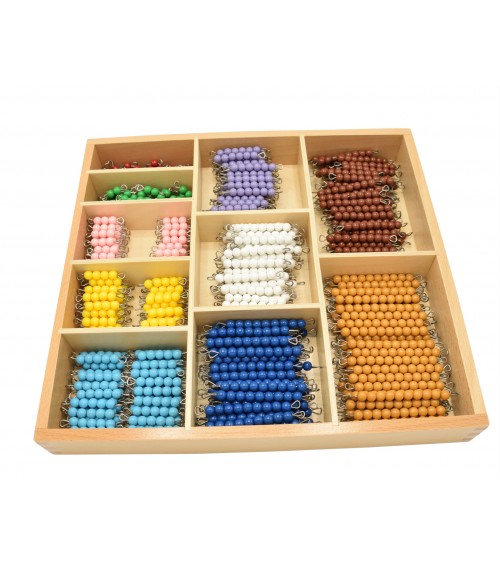Large colored Montessori Bead Material
Large colored Montessori bead material, with enough bead sticks for practicing multiplication
over 550 parts, with storage
The coloured pearl material is probably one of the most famous Montessori materials. This set contains so many pearl sticks that even the painting rows up to 10 x 10 can be laid out. This makes it much easier to calculate multiplication tasks with the material. The child sees intermediate and final results. These are particularly easy to imagine because of the pearl material, as it is tangible and visible.
Use, advantages, areas of application for this Montessori material:
-
- Process addition problems
-
- Practice subtraction problems
-
- Get to know the number range up to 10
-
- Pearl material for children from 4 years
-
- Internalize numerical values
-
- Learn the basics of multiplication
-
- Understand the relationship between addition and multiplication
-
- Practice the 1x1 rows up to 10 x 10
-
- Montessori bead material for children from 6 years
Scope of the Montessori pearl material:
1 wooden box with lid approx. 30 x 28 x 3.5 cm
pearl material, plastic on wire, pearl diameter approx. 7 mm:
55 one red
55 two green
55 three pink
55 four yellow
55 fiver light blue
55 Sixes purple
55 sevens white
55 eights brown
55 nines dark blue
55 tens gold
Instructions for multiplying with colored bead material
Times tables
The adult puts out two of the 3-sticks. By counting, he determines:
3 + 3 = 6 and 2 x 3 = 6. This is checked further using other numbers, e.g. 3 + 3 + 3 + 3 = 12 and 4 x 3 = 12 or 5 + 5 + 5 = 15 and 3 x 5 = 15 .....
Then he takes, for example, four of the double sticks and places them on the table in front of him (that's four times the two). Now he takes two of the 4-sticks and places them next to them (that's twice the four).
He places the 4-sticks over the four 2-sticks and realizes that both are the same size. As a control, the pearls of both calculations are counted and compared (4 x 2 = 8; 2 x 4 = 8).
The tasks can be written down in a notebook.
Multiplication by 10
The adult places ten treble sticks one below the other (that's ten times the three).
These tasks can also be noted (10 x 3 =).
The bill is replenished with 10-sticks (the 10-sticks are held over the field with the 3-sticks and you notice that three 10-sticks are required). The result is noted and further multiplications by 10 are performed.
At the end the child will recognize that when multiplying by 10, a zero simply has to be appended to the multiplicand (10 x 3 = 30; 10 x 4 = 40; 10 x 5 = 50 ...).
further multiplication
problems place the snake 3 times 2 + 3 + 4 place
the snake 4 times 5 + 6 + 8 ...
Variations:
If the golden pearl material is available, the
multiplication tables are removed and the results with the golden pearl material are added: multiplication table with 7: a 7-stick is placed on the table (one 7) underneath seven golden single pearls. To the right of the first two 7-sticks are placed one below the other (twice 7). As a result, the 14 is placed under this field with the golden bead material (a 10-stick and four single-size pearls). The multiplication table is continued in the same way.
Instructions for the Montessori bead material
The adult takes a bead stick from the wooden box and places it on the table, aligned left, from top (largest) to bottom (smallest).
Starting from the bottom, he takes out each pearl stick one after the other and counts the pearls individually (one pearl: one - that's one; two pearl sticks: one, two - that's two; three sticks: one, two, three - that are three ...).
After that it is handed over to the child.
Variation:
The row is laid out again. Some chopsticks are removed (one after the other or at the same time), which the child puts back in the right place.
The adult takes two chopsticks from the wooden box, e.g. the 6 and 8 sticks and asks the child which stick goes in the middle (here: the 7 stick).
Exercise for number decomposition: a bead stick is selected and placed on the table.
Which chopsticks are the same size together as this one? (e.g. for a double crochet: 7 + 1, 6 + 2, 5 + 3, 4 + 4, 3 + 5, 2 + 6, 1 + 7). These tasks can be noted in writing. When making notes, the swap tasks should be one below the other, i.e. 5 + 3 and 3 + 5 or 6 + 2 and 2 + 6, to make it clear that the result is always the same here.
Simple bills can be submitted.

